This is one of two hand-built prototypes of the 355 Baldwin.
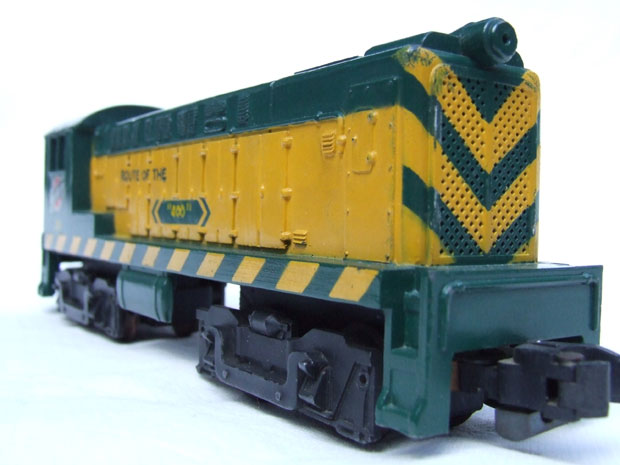
Maury Romer authenticated this item for me, and explained that when they made a new item like this, they would usually start with 2 samples – one for photographic use and one to display at the Toy Fair. I was aware of a second of these that at one time was in a collection in Ohio, but I am not sure where it is now. It is interesting to compare this prototype to the picture of the set on the bottom of page 4 of the 1956 catalog (D1866 or D1867).

The item photographed in the catalog matches mine exactly, with only two exceptions – the presence of the air horns on the hood, and the diagonal stripes on the running boards run the opposite direction. Therefore I conclude that the one that was in Ohio was the one for photographing, and mine was for display at the 1956 Toy Fair.
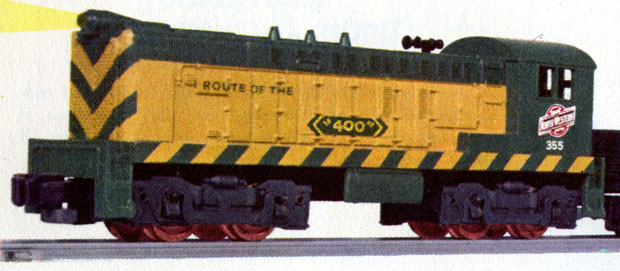
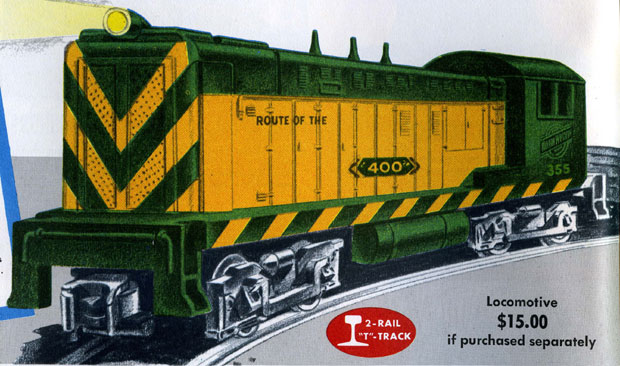
As far as construction, the entire thing is hand made and hand painted, with the exception of the wheels, axles, couplers, and coupler centering springs (all of which were parts that were already in use at that time). All other parts would have been new, and were hand made. Pay particular attention to the construction of the steps, which differs significantly from the later production moldings. There was no attempt to make this item operational – the trucks used a block of wood, and the wheels do not even spin.
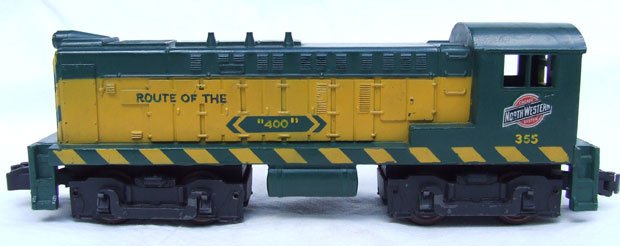
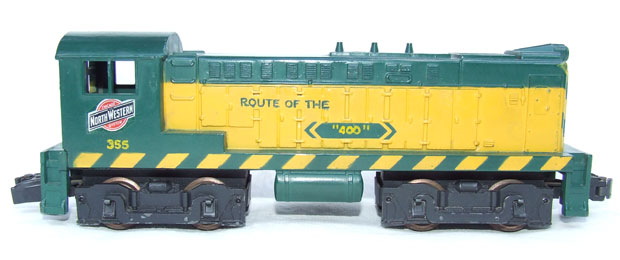
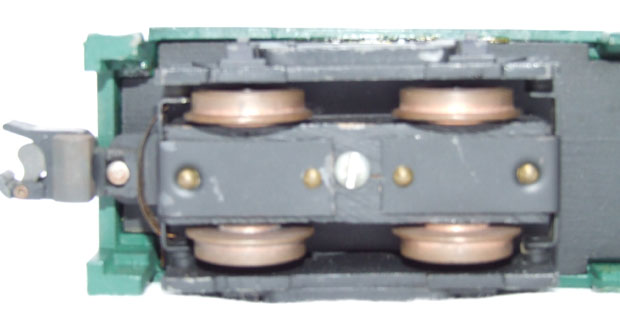
I bought this prototype in 1982 when Stewart Bearn, one of the charter members of the Train Collectors Association (TCA), was auctioning off much of his collection. He explained that he obtained it in 1956 when he worked at a hobby shop in the Philadelphia area. He was once given the task of driving a truck to New Haven to pick up an order, including a dozen of the cheapest catalogued sets which the store was going to offer on sale to attract business. He remembered that one of the sets was in a much bigger box than the others, and this was sold to the first customer who came in to buy a set. That customer returned to the store later that day carrying this engine, and explained that the box did not include the set he was expecting; he was not upset about this, because there was apparently a lot of other stuff in it, but he did not have a set to run because this engine was non-operational. They accepted the non-operational engine from him and gave him another set, and since the engine was worthless to the store, Stewart took it home, not knowing what it was or how it got in the box.
When asked about this, Maury Romer figured out what must have happened. First, note that at that time, Gilbert had an employees’ store where workers could buy any catalogued item at half the catalog price. After the 1956 product line had been determined and developed in early 1956, there were a number of items on shelves in Maury’s office. Later that year, not needing them anymore (or perhaps to make space to start on next year’s line), Maury assigned someone the task of putting all these items in a large box and taking them down for salvage, disposal, or storage. This worker packed them in the box, but instead had it sealed and labeled as the cheapest catalogued set, and took it to the shipping dock, with the intention of buying the contents for half the price of the cheapest set. However, before he could pick it up after paying for it, it was mistakenly thought to be part of the hobby shop’s order and loaded into Stewart’s truck.
It takes time and money to maintain a
website like this. If this site is interesting and helpful
to you, please contribute financially to its ongoing success.
You may send a contribution via PayPal using
theupstairstrain@gmail.com as the payee. Both credit card and
direct transfers would be greatly appreciated. Thank you very much.
If you or your friends have some American Flyer
trains and would like them to go to a nice home where they'll be
loved and cared for, this is the place! Email me:
theupstairstrain@gmail.com. See my Wish List
for the items I need most. Thank you very much.
On the other side of the coin, I post pictures from time to time on my
For Sale page of surplus items I have for sale.
This gallery will continue to grow and become more
comprehensive as I collect more cars and as visitors like you send
me pictures of the cars I don't yet have. If you have a car
that you would like to share with the world, email me a picture: theupstairstrain@gmail.com.
Click here for a list of the pictures I need
to complete the Gallery.
The books I am using for reference
are listed in the Bibliography
page. All the writing and all the pictures on this website are, however, my own, except where cited. No
copyrighted materials have been included and all pictures provided
by others are used by permission.
Now show me:
The Gilbert Gallery Home Page
Engines
Passenger Cars
Freight Cars
Freight Sets
Work Cars
Accessories
Infrastructure
Atlantic Steam Engines
Pacific Steam Engines
Hudson Steam Engines
0-8-0 Steam Switchers
Northern Steam Engines
B-6sb Steam Switchers
Dockside Steam Switchers
Casey Jones Steam Engines
Mikado Steam Engines
Berkshire Steam Engines
Challenger Steam Engines
Y-3 Steam Engines
Alco PA Diesel Engines
Geep Diesel Engines
Baldwin Diesel Engines
F-9 Diesel Engines
ES44AC Diesel Engines
SD70ACe Diesel Engines
U33C Diesel Engines
U36C Diesel Engines
GE EP-5 Electric Engines
Handcars
Pictures Needed
Useful Links
For Sale
Wish List
Bibliography
The Upstairs Train